Melvyn Penn
Expectations
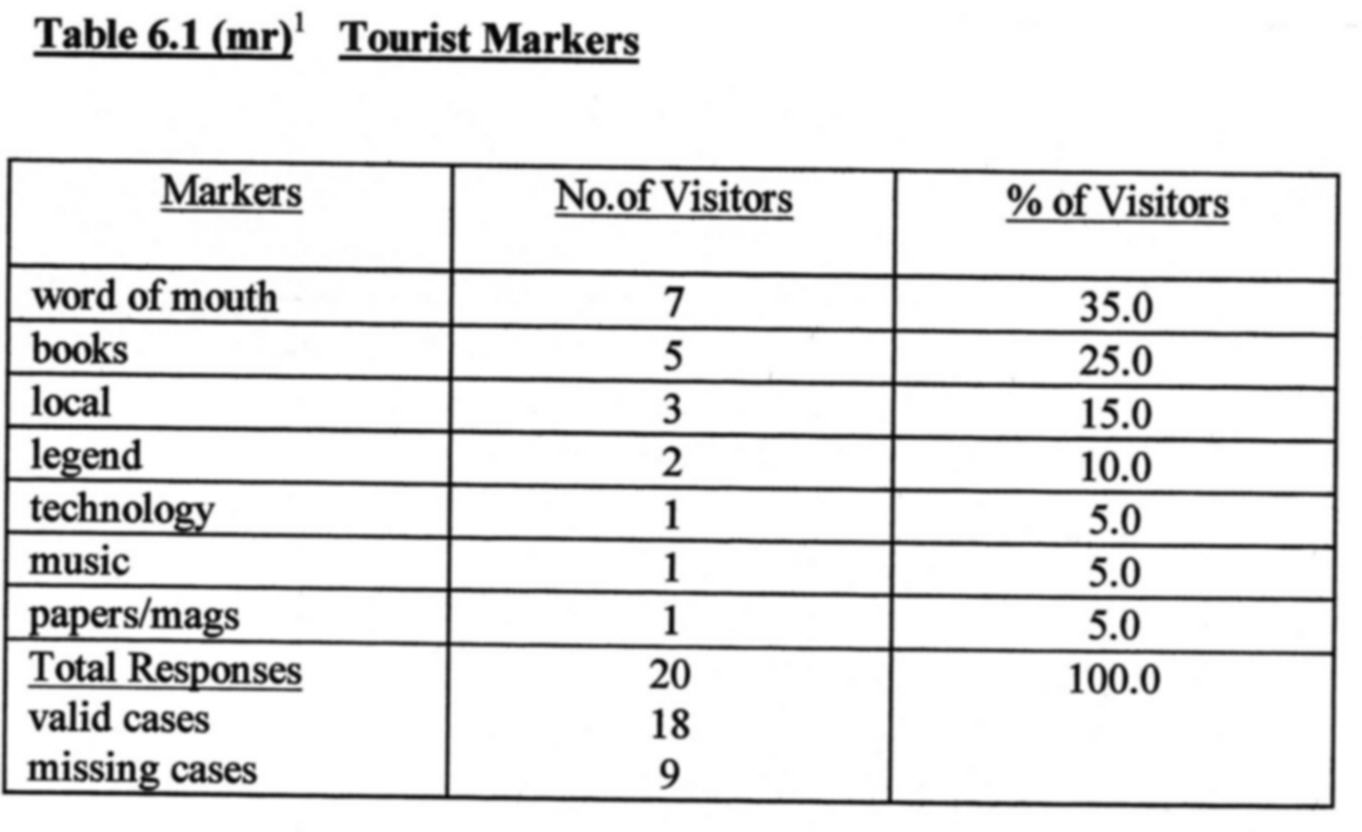
1 mr = multiple response. Duer to the open nature of the qualitative question, respondents may have given more than one response. Total responses may therefore be irrespective of valid cases. See also coding in appendix
We can recall, from Robb (1998), that due to the fragmented nature of the markers concerning Tintagel it can be a matter of chance which perceptions visitors will arrive with.
When visitors were asked to recall how they first came to hear of Tintagel, table 6.1 shows that a variety of sources were quoted. Those respondents who cited books as a marker were not able to specify which format We have explored a range of books from romantic Arthurian tales by Tennyson (1859-69) to more factual books such as that produced by English Heritage (Thomas, 1993), [find references here] each exerting various discourses.
The category 'local' prompted a spontaneous reaction from visitors who were already in the area. One of these respondents heard about Tintagel while visiting nearby Boscastle, while others were attracted by local waymarking. Considering it's appeal to the short-break market, Cornwall can act as a potentially lucrative marker for Tintagel when the markers can be seen to speak the same language. A language that speaks in environmental terms as well as economic. This is very achievable as far as on-site markers are concerned. Waymarking, when it is constructed conservatively, will merely point the way to Tintagel and let the visitor discover for themselves.
Those respondents who had heard about Tintagel by word of mouth had done so from friends and relatives that had been here before. Reminding us of the perpetual nature of touristic discourse, Dann (1996a) claims that tourists may actively promote their experiences on to others using a variety of visual aids and that “…they often resemble the very brochure pictures through which they were lured to the destination in the first place” (Urbain, 1993:63).

We may recall from Boorstin (1964) that the romantic content of the markers may lead visitors to expect their vacations to be equally exotic. When we come to examine visitor expectations we can see from table 6.2 that the atmosphere was the most popular response. A quiet but friendly experience was generally anticipated, harmonised with cold and possibly wet weather. One of these respondents expected Tintagel to be windswept and forbidding, while for another the atmosphere would be simply romantic. The romantic atmosphere that is being described here is most likely to be sampled at this time of year. Exotic it certainly is not and the image would appear to be far removed from the sunny blue skies of the brochures. As these expectations appear to contrast with the rhetoric of the markers we need to decipher their formation.
During repeat visit we saw how the discerning nature of the visitor could affect patterns of behaviour; repeat visitors were likely to make frequent trips to Tintagel but stay for a shorter duration of time than first time visitors. There is, then, another marker to bring into the equation and it is that of Tintagel.
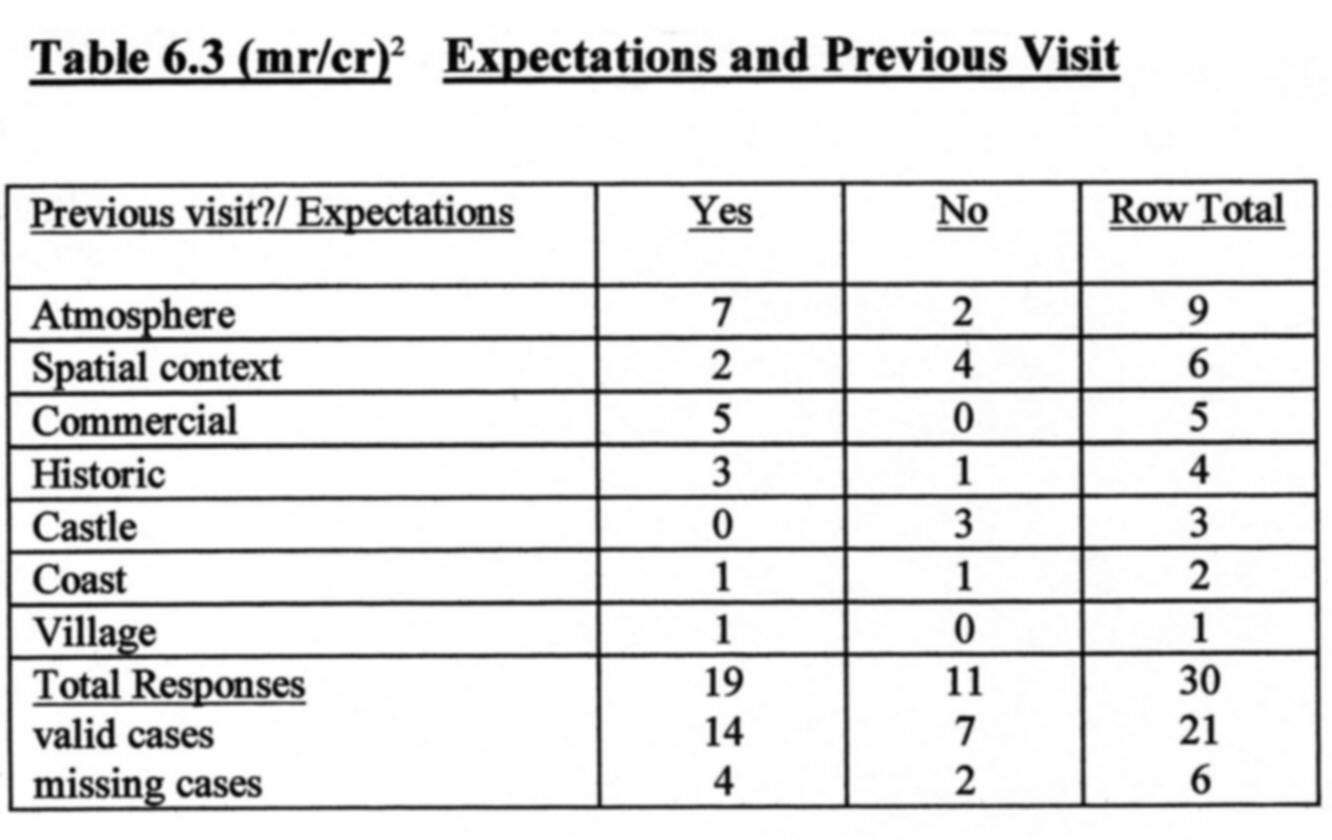
2 -- mr/cr = multiresponse and crosstabulation.This is about as advanced as we get.
The responses in table 6.3 show the contrast between visitor expectations and the rhetoric of the markers to be strongly associated with a repeat visit. Of the 9 respondents who expected to find this atmosphere at Tintagel, 7 of these been here before. Their expectations were not based on illusory images but on past experience. Another striking contrast is with the commercial offering that was expected. All 5 respondents who expected Tintagel to be commercial had visited before, whereas for first time visitors, patrons of off-site markers, the commercialism appears to have been heavily disguised.
The atmosphere and the commercial can at once be seen to be complementary and speak volumes about the ethos behind Tintagel. Surely an atmosphere is something that can only be experienced? The markers, however ingenious, can not fully capture the potent atmosphere at Tintagel. This is where mythology can come into play. Tintagel has precisely the kind of setting that Arthurian myths are made of. I would sometimes wander along the cliff tops at dusk and, in this eerie romanticism, it was easy to conjure the appearance of some kind of mythical apparition. The construction of the myth can therefore be seen as an attempt to capitalise on an external good. One may question whether Tintagel needs philanthropy to increase it’s status when it is blessed with such natural charm. It is an issue that we shall frequently address.
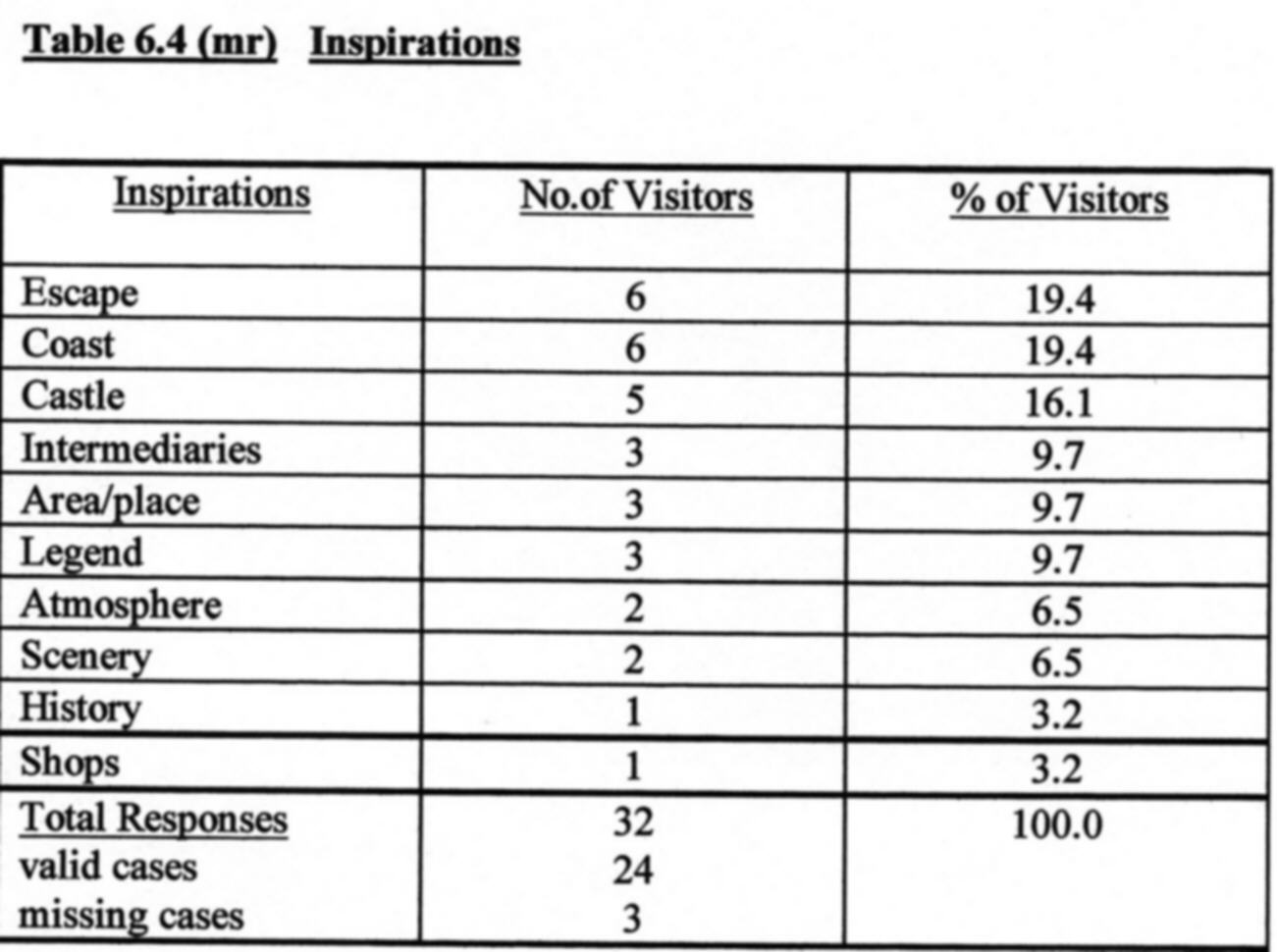
According to MacCannell (1989) the tourist can not escape this commercialism. Under the consumer gaze we saw how modern life is pervaded with entrepreneurialism. Many kinds of escape were considered but the tourist experience was also termed a type of product, a cultural production, and so the tourist quest can remain illusive. Before we advance from expectations we should wish to understand how Tintagel fits into this scene. Visitors were asked what else had inspired their visit.
Table 6.4 shows that the quest to escape did inspire visitors to Tintagel alongside the more natural element of the coast. Escape to the coast? The question arises, can Tintagel genuinely offer something unique or can these expectations be linked to the rhetoric of the markers?
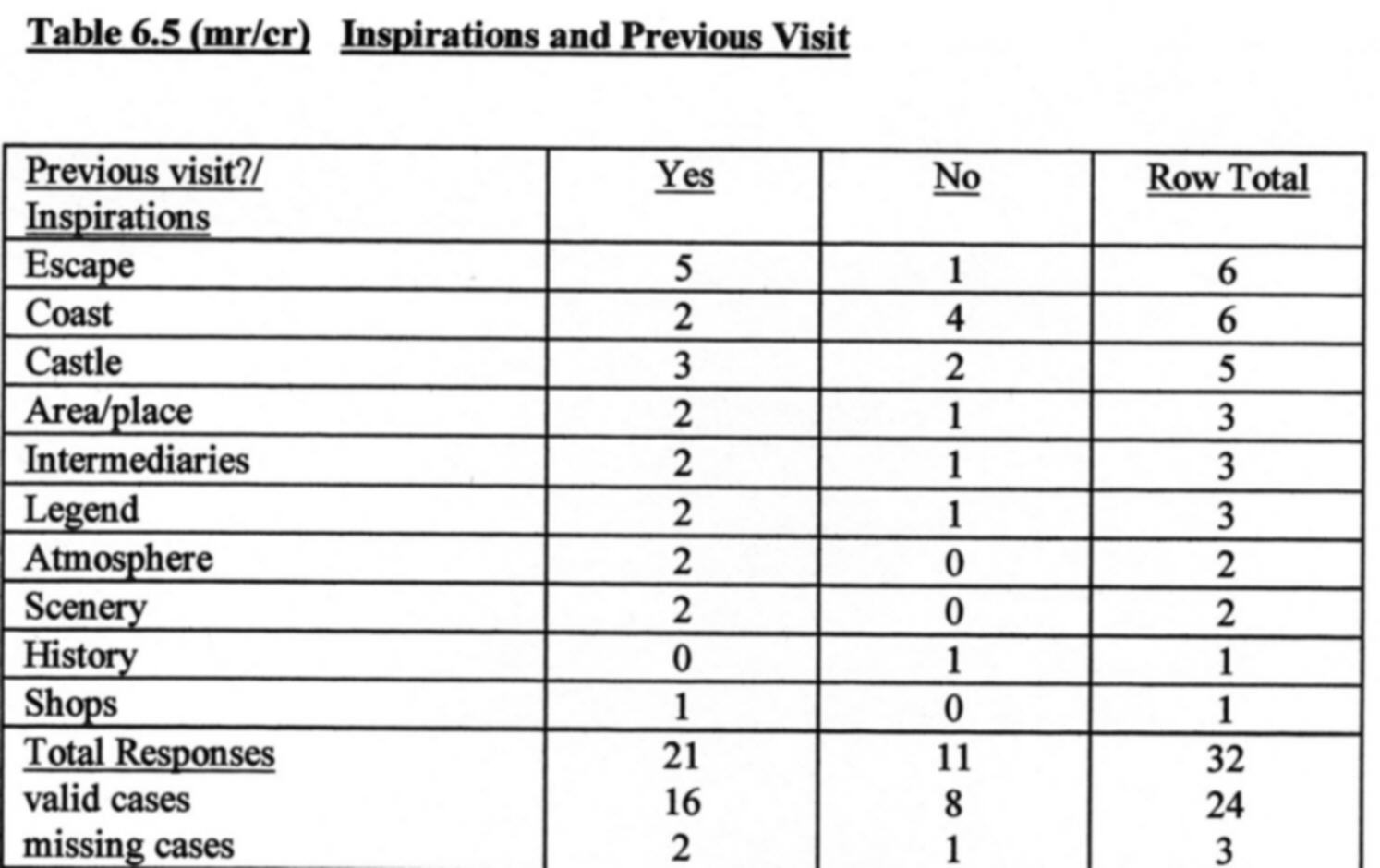
We can see from table 6.5 that of the 6 respondents who were inspired to escape, 5 of them had previously visited Tintagel before. Reverting to table 6.3, we may also recall that repeat visitors were very aware of the commercial aspect at Tintagel. When taken together a pattern emerges that, despite this commercialism, the discerning visitor does seem able to escape the consumer gaze and experience something different at Tintagel. So much so that, for some repeat visitors, Tintagel was just too good to keep to themselves. These respondents took the opportunity to act as intermediaries and show off Tintagel to someone else. This kind of demeanor was discussed by both Dann (1996a) and Gottlieb (1982), that the quest for escape can be heightened by personifying other peoples and roles. In this instance, the behaviour would appear to be associated with the quality of the experience.
Activities
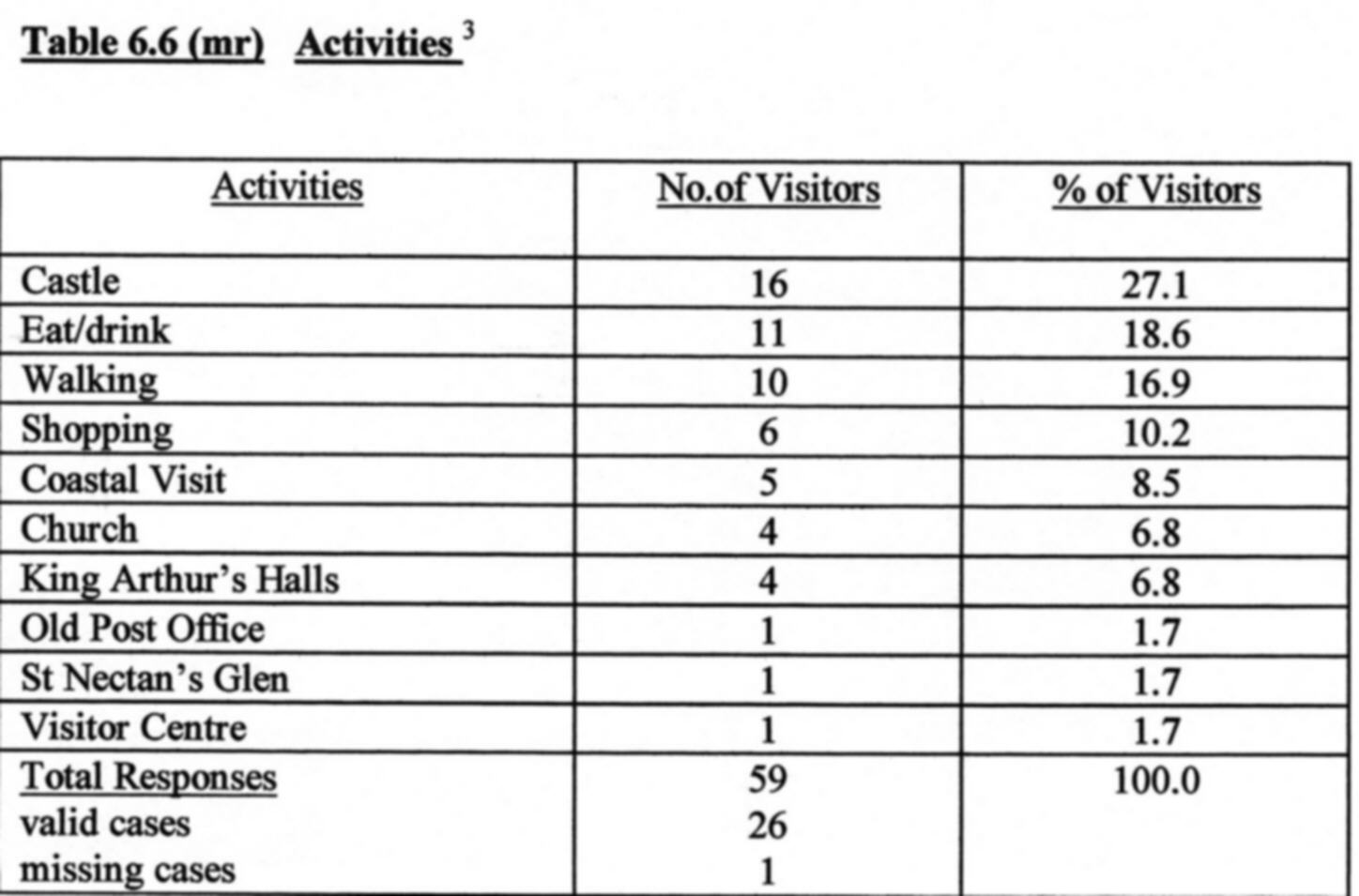
3 -- Activities have been calculated by combining what the visitor has done so far with what they intended to do. See also coding in the appendix
As we proceed to the more tangible aspect of activities, it is necessary to also bring an element of empiricism to our findings. It comes in the form of the climatic conditions that were present at the time. To put it amicably, I got soaked on three of the four days that I conducted my questionnaires. This did not come as a great surprise to me and I was well prepared with a waterproof clipboard and hi-tech protective clothing. But how would the visitors respond?
If we revert to our textual analyses of atmosphere in table 6.2, we could anticipate the discerning visitor to be prepared also. And the visitors did seem prepared! Everyone, it seemed, was dressed in waterproof clothing like me, although not as sophisticated, of course. We can confirm from table 6.6 that despite the adverse weather conditions, walking and coastal visit were still popular among respondents and the Castle, which is also situated on the headland, was the most popular. Let us not get too carried away. As Cohen (i.e.1979) would always remind us, there are many types of tourists and experiences and we can not expect such a positive reaction all of the time. Both eat/drink and shopping are activities that also scored highly and this indicates that the weather may still have exerted some influence .
In our semiotic analysis of Tintagel, Thomas (1988) found that nearly a third of visitors desired only to patronise the shops and, we saw from Boney (1959), how visitors did not always make the most of Tintagel. We have discovered ourselves how visitors have spent a short duration of time here and have suggested how this could provoke an impressionistic account. This is likely to be a pessimistic one, it can be seen, when the visitor confines themselves the enclave of the village. We might well ask, do those who go shopping only go shopping? Table 6.7 examines the utilisation of visitor activities at Tintagel.

A cursory glance at the ratios for
each of the time cohorts can reveal that total responses exceeds valid
cases, mostly by at least 2:1. Through our example of shopping, let
us turn to its most popular time cohort to clarify this point. The
12 respondents who stayed only between 0-3hrs at Tintagel were the proponents
of some 23 excursions among the various activities. This suggests
that those visitors who went shopping were also likely to have consumed
at least one other activity, a visit to the Castle perhaps. On this
evidence, even during a short visit, visitors did not tend to confine themselves
to the village and were likely to gain a fairly realistic impression of
Tintagel.
Setting
The purpose of this section is to provide a link between the activities and the experience by examining the context in which the two components take place.
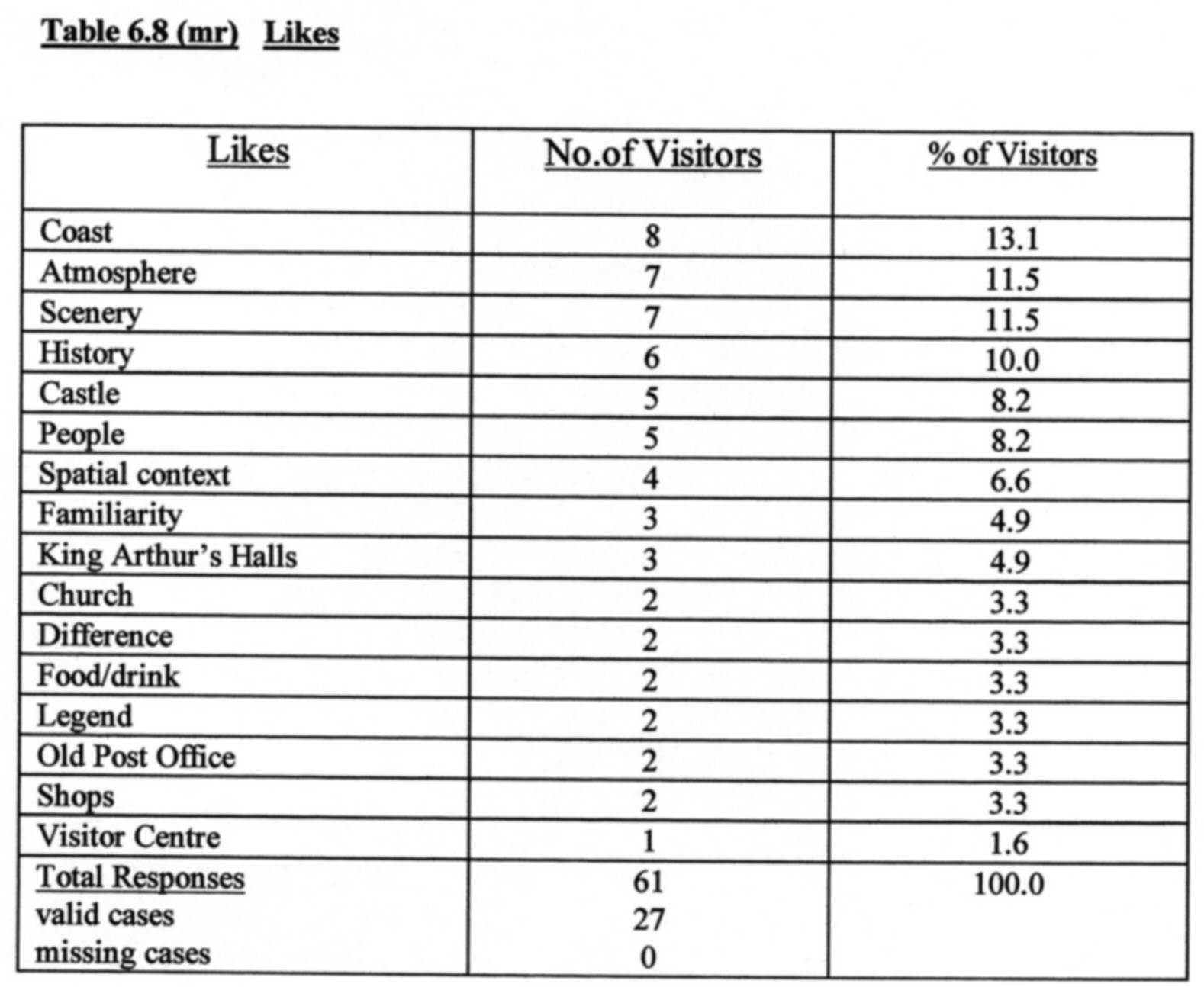
Visitors were free to name anything that they liked about Tintagel. Table 6.8 verifies how an emphasis is placed on both the natural and the intangible setting. It can be seen that none of the top four responses require a direct payment from the visitor. So, although Tintagel Castle was listed as North Cornwall's third most visited paid attraction in 1995 (North Cornwall District Council, 1998), we find it is only the (equal) 5th most liked component of Tintagel among our respondents. Visitors seemed more interested in the history that Tintagel conveys, rather than any tangible setting. An example of this is the Old Post Office, which was liked by 2 respondents even though it is closed at this time of year and could only be admired from the outside. In a sense the question has failed to provide us with a working answer for an intangible setting can not be attributed to anything in particular. Rather, it can be seen to add value to the tangible.
What kind of a value can be assigned to an intangible setting then?. We are speaking in terms of a hidden value, one that can not be readily converted into monetary terms. Here we are reminded of the sensitive balance between cultural capital and real income that was discussed in our quantitative analysis . Lose some of the atmosphere at Tintagel and there is the danger of losing the visitor as well. Advocates of spatial context seemed to be well aware of this balance, as the freedom to roam around Tintagel was considered to be an important rite. One of these respondents associated the access walk to the Castle with this freedom and another mentioned National Trust land. Regarding Tintagel Castle, visitors are only currently charged by the English Heritage upon entering the ruins and not for the access walk through the valley. The present researcher is unaware whether the proposed links to the Castle might change all this, but if the visitor is to pay for an external good then alternative methods might be considered. The donation boxes that are administered by the National Trust are a good example as they do not incur fixed values or restrictions .
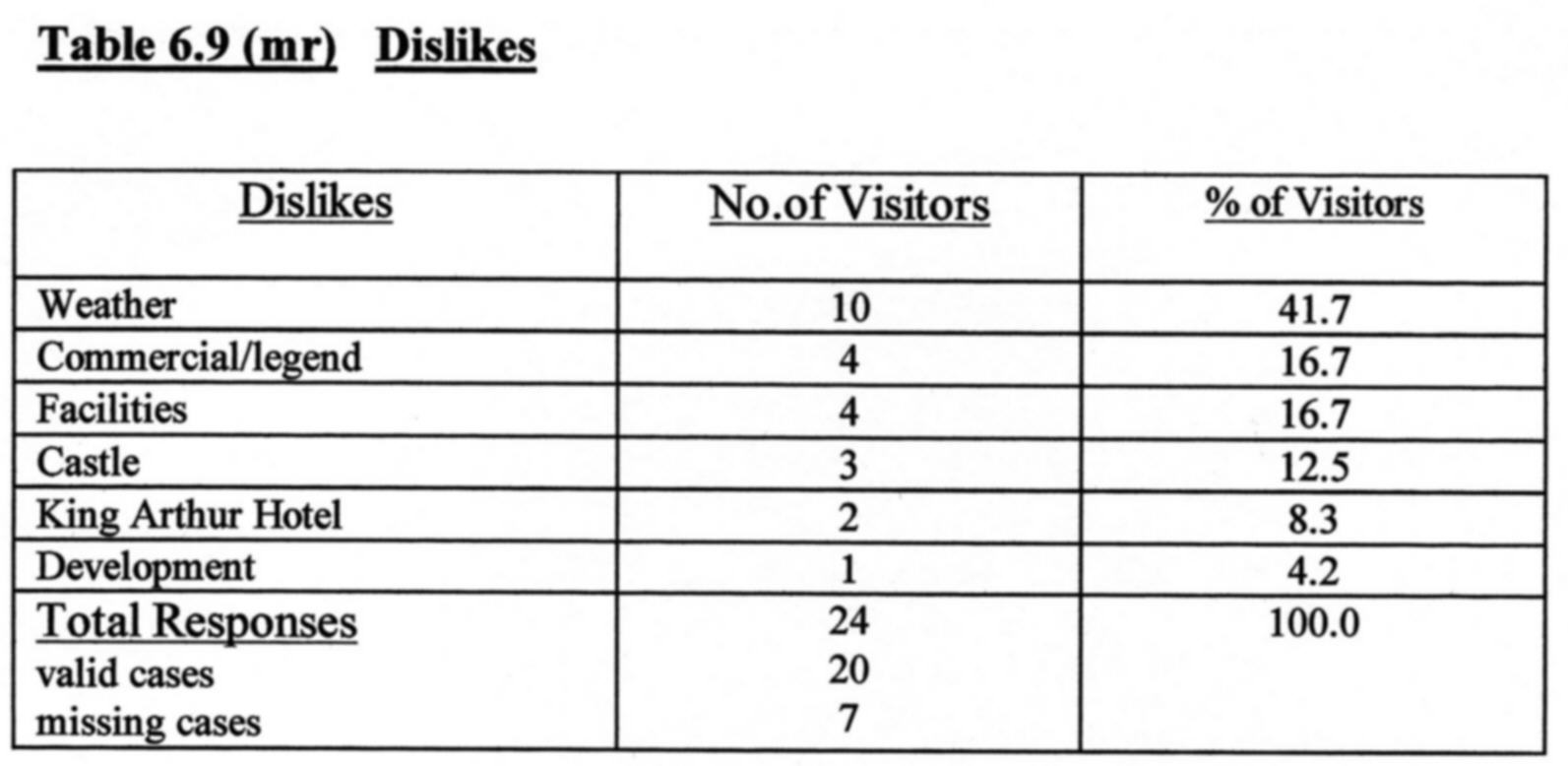
The complementary nature of tangible and intangible values is very prominent here. Having discussed how Tintagel can provide an escape from the consumer gaze, table 6.9 suggests that our respondents were not total explorers, in Cohen's (1972) terms. The contempt for the weather and facilities shows that although the visitors were likely to brave the weather conditions and sample the outdoor activities, some comforts and amenities were still being sought as if for compensation. It seems that Tintagel has difficulty in providing these facilities at this time of year.
One evening when I decided to dine at a particular restaurant that I fancied, I found to my dismay that it was closed at weekends. This was typical of the almost random opening times of some of the shops and facilities here and it is little wonder that visitors expressed their contempt. The root of the problem may lie in the harsh living and working conditions that are present. A restaurant owner told me that Tintagel’s remote location means travelling for long distances to stock up on food and that these costs must be passed on to the consumer. Similarly, the customer must pick up further surcharges if they pay by cheque or visa because there are no facilities nearby for employees to cash them. And if the customer decides to pay by cash, well, there is no cash machine at Tintagel and the only bank is open for two hours a week. It is a catch situation. Visitors can not afford to pay the higher prices so they go elsewhere. Consequently, it is not worth keeping enterprises open all the time and then visitors complain of a lack of facilities. It is easy to see why there is a certain dependency on tourism here but the answers may not lie in the commercialisation of the Arthurian myth. They may even penetrate beyond improving the aesthetic appeal of the village. There would appear to be a compelling need for authorities to provide adequate facilities for the local community first and foremost if the tourism industry is to flourish here.
Experience
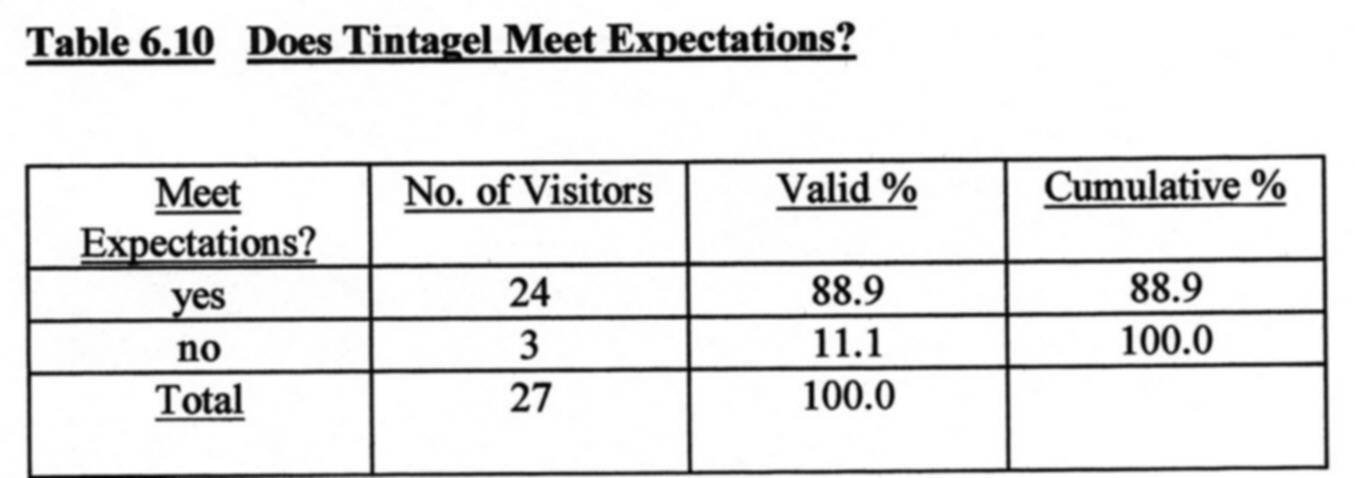
The only closed question in this qualitative section, visitors were simply asked whether Tintagel has met their expectations. Table 6.10 shows that yes, Tintagel did not disappoint, and the emphatic margin over no responses gives the answer some reverence. Project over! The promiscuity of the markers does not exceed the visitor experience at Tintagel. Not so fast. We have seen how knowledge can not be taken for granted when we investigate the social sciences and Ireland (1990) acknowledges that in attempting to define experience its meaning is sometimes lost. We have seen how the visitor experience is based on a series of events and encounters, each with varying degrees of influence. It was therefore deemed necessary to also ask visitors if they could provide some reasoning behind their answer. The responses are displayed in table 6.11.

The element of the experience that was most likely to meet the expectations of the visitor was the atmosphere. This comes as no surprise to us as it verifies what we have seen all along. In accordance with expectations, the atmosphere was found to compose of a pastiche of sentiments; wild, rugged, quite, and friendly. Others simply described it to be 'magical' or 'spiritual'. The atmosphere was not to everyones liking, however, as one respondent who found that Tintagel did not meet their expectations reprimanded it a 'spooky place'.
The area/place can be seen to complement the atmosphere. These respondents found the very act of being in Cornwall to be an important part of the experience. In expectations we saw how Cornwall could act as a lucrative marker for Tintagel and the very name may, perhaps, conjure images of Denys Val Baker’s ‘The Spirit of Cornwall’(1980) and ‘The Timeless Land’ (1973).
In this instance the marker involvement serves to complement the experience, rather than to jeopardise it. When we looked at anticipating the experience, we saw from MacCannell (1989) that tourists may fail to see the sights visit they visit as they perform a 'double take', exchanging perception with recognition. Even if one was familiar with Val Baker’s works it would be difficult to exchange a sense of prestige (being in Cornwall) with a perceived image. Reverting to table 6.10 and our disclaimer, it would seem that the visitor experience is most likely to exceed the promiscuity of the markers when there is a strong emphasis on the intangible components. When the markers can readily portray the sight, such as the coast/scenery in table 6.11, we find a creeping intervention as this component was not so popular.
The coast/scenery is a deliberate example (the Castle would have been an easier option) to illustrate that this discovery is not concrete either, and also the complexity of the concept of meaning. The coast/scenery may of course be easily associated with the atmosphere and has scored highly in tables 6.8 (likes) and 6.4 (inspirations) and lowly in table 6.2 (expectations).
Satisfaction
Having discussed the anticipatory stage and the visitor experience at Tintagel, we are now in a position to prophecise what perceptions the visitor will take away with them and how this may contribute to future discourse.
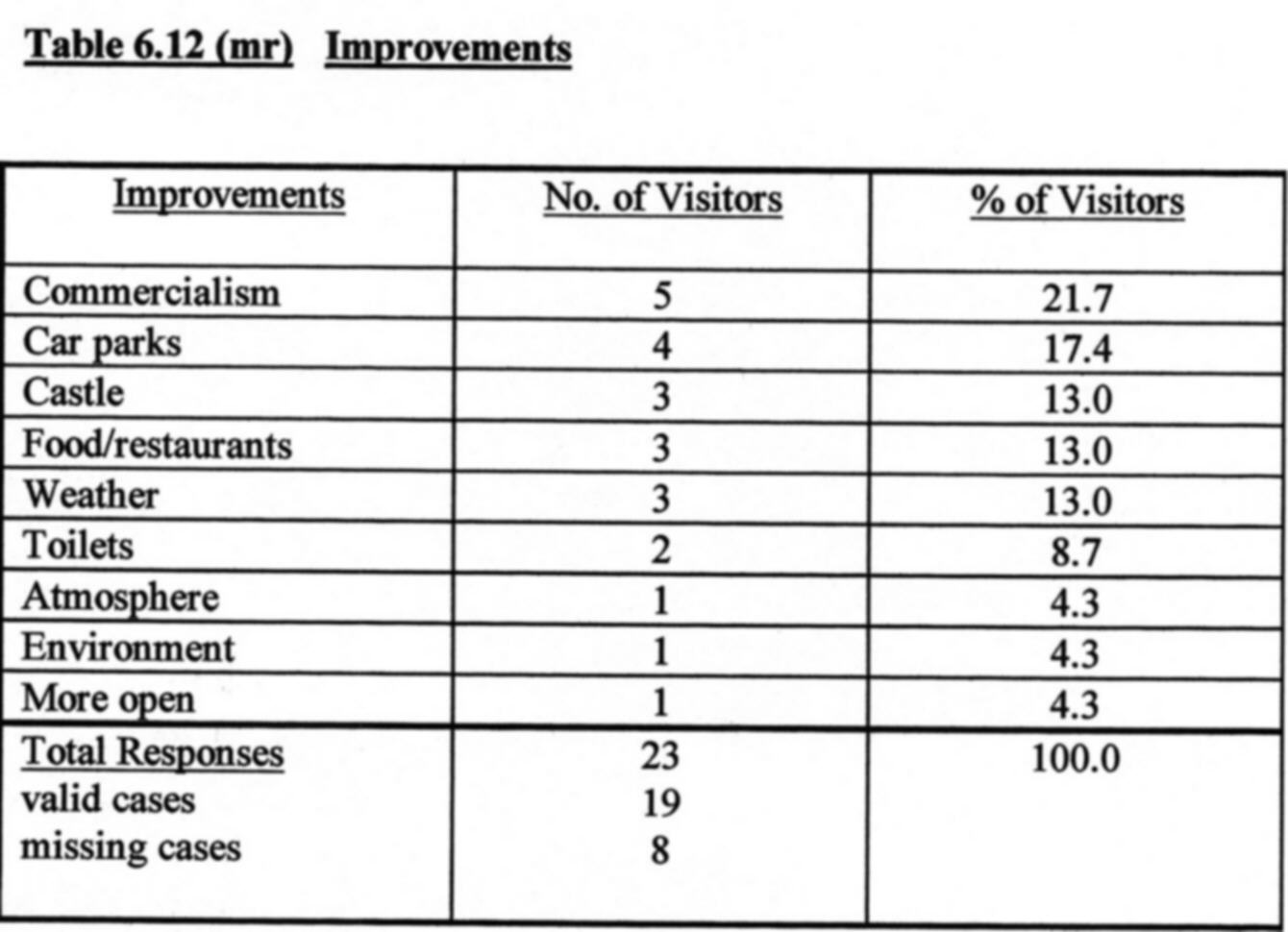
From table 6.12, the commercialism was the aspect of Tintagel that visitors thought could be most improved. It is important to note that this commercialism was not just thought to be confined to the village. Reverting to table 6.9 (dislikes), the King Arthur Hotel was thought to have inflicted a tacky appearance on the coast. Neighbouring the Hotel is Tintagel Castle but this was not perceived to be commercialised. It was the presentation of the myth that was criticised rather than the purpose. The 'rubbish gifts' and the 'tacky' nature of shops and buildings were perceived to subvert qualitative interpretation.
The aspect of the Castle that visitors did think could be improved was the long, steep flight of steps on the approach. Visitors are required to climb in access of a hundred steps and cross a steep wooden bridge to make the transition from the mainland to Tintagel Island, and hence the Castle. The less agile visitor would sometimes accompany me with my research while the other members of their party proceeded to make this transition. A poor substitute indeed! The difference between only seeing the Castle and actually experiencing it is, as we have seen, one that could easily result in disappointment.
As the markers enthusiastically convey images of romanticism and authenticity, the visitor can remain uninitiated about more practical information. It is to this contrast in authenticity that we now turn. Authenticity has been seen to be fundamental to tourism and we can recall, that for MacCannell (1989), the tourist seeks for authentic structures that have been made absent from modern life. The tourist may always desire authenticity but is authenticity always desirable? The bridge to the Castle was only constructed during the 1970s and before the Castle passed into the hands of the English Heritage, visitors would have been required to climb a steep path up a natural saddle in the cliffs. If the Castle was to remain authentic, then the flight of steps and the bridge would never have been constructed and access would be denied to an even greater number of visitors.
A sensitive balance is required if natural structures and environments are to be retained and visitor numbers are to be simultaneously attracted. The answers may lie with good visitor management. This might entail that visitors are made aware, both off-site and on-site, as to what they are likely to encounter and why.
The strategy may be applied to the utilisation of car parks, for example. If visitors wish to explore the Castle, or any other aspect of Tintagel for that matter, they are requested to park in one of three places. One car park is situated in the centre of the village in Fore Street, one is in Bossiney Street by the Visitor Centre and another by the entrance to the Castle. The problem being that visitors seemed to associate each car park with each attraction respectively. I observed how visitors would compete for space in the car park in Fore Street, often resulting in a spillover onto the street, while the other car parks remained neglected by comparison. Consequently, visitors complained of having parking difficulties, the aesthetic appeal of the car parks and at having to pay out of season. If practical measures are to be deployed to achieve an equilibrium then the visitor might be enlightened as to how Tintagel would benefit
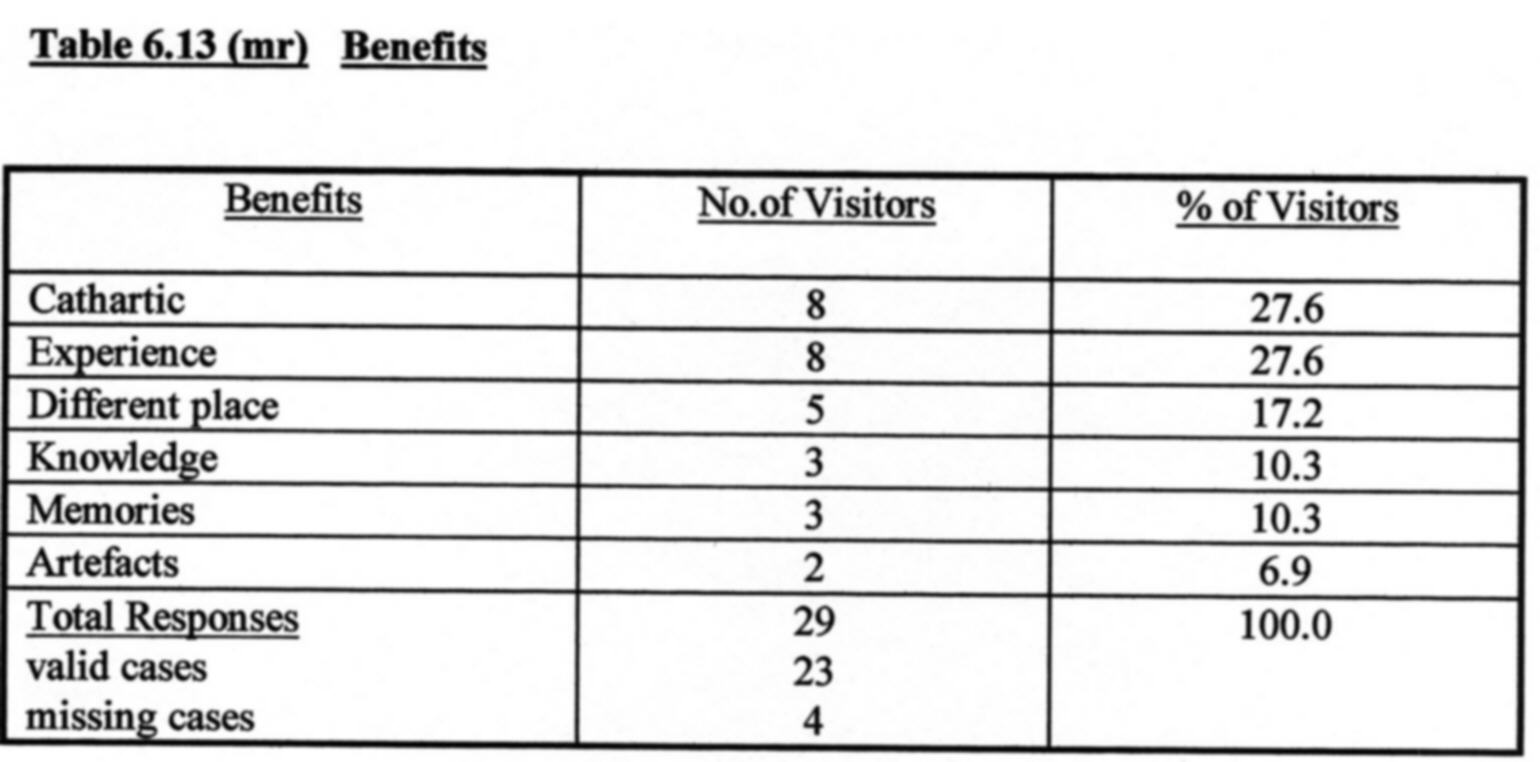
Table 6.13 shows how the visitor might have benefited from Tintagel. Those who felt they had benefited from a cathartic experience found that Tintagel could exert a sense of relaxation, calm and peace. While those who thought they had gained from the experience enjoyed the fresh air, the lovely scenery and the sense of history. This sense of being in a different place or a different time was most strongly felt by those visitors from overseas, accounting for 3 of the 5 respondents in this category. Tintagel would appear to retain a certain uniqueness at this time of year that can provide a temporary respite from the consumer gaze.
What happens when the visitor returns from Tintagel? In table 6.1 we saw that word of mouth was the most popular marker among our respondents and, from Dann (1996a), how tourists may act as promoters and relay their experiences onto others. How can we tell whether visitors will pass on their likes or their dislikes, improvements or benefits? There are no easy answers but some inferences can be made. We have suggested that a cathartic experience such as relaxation can not be fully captured by the markers but neither can it be packaged and taken away. It must be committed to memory. The visitor might then turn to more pragmatic examples to portray their experiences, such as artefacts and textual knowledge.
Tintagel is clearly a resort that needs to be experienced and while the various markers continually strive to capture this experience it seems there will always be some contrasts. It can therefore be a matter of chance as to what knowledge or artefacts are consumed and passed on by the visitor and how accurately they represent the experience. While these discrepancies exist, calculating visitor satisfaction at Tintagel is always likely to involve some guesswork. No doubt, there will be those who will come to Tintagel and feel just like du Maurier (1967), who's expectations were shattered the moment she crossed into Cornwall, and there will be those for whom Tintagel will cast a spell that is hard to break. We might conclude from our analysis that most visitors will fall somewhere inbetween and express varying degrees of satisfaction across various components.